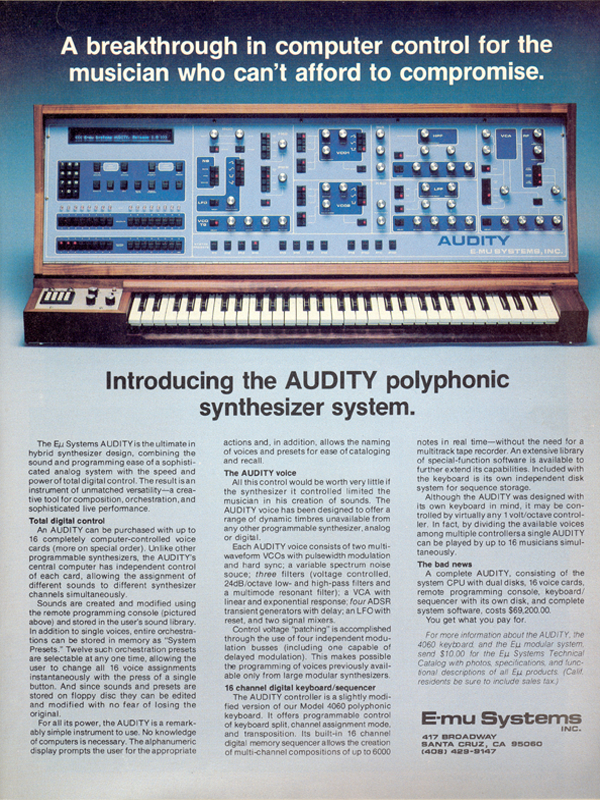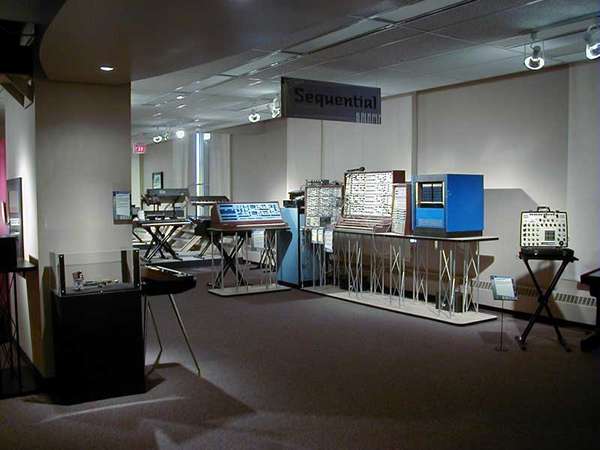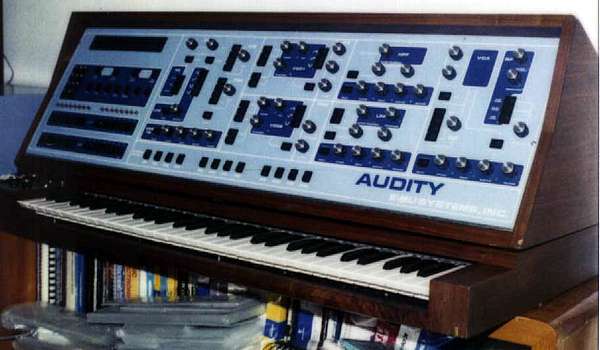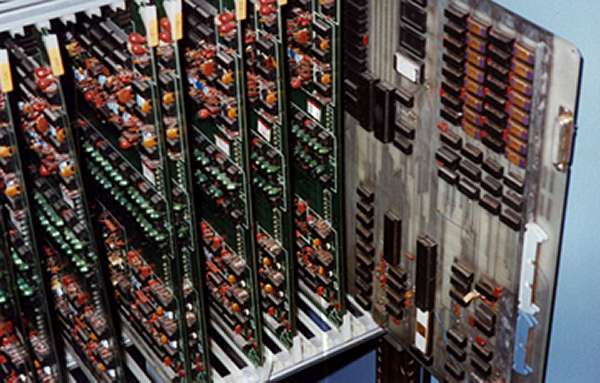Audity
Audity Overview
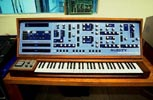
The Blue Box At the end of the 1970's E-mu Systems began to develop synthesizer chips with Sold State Music - the famous SSM range. Initially they were used as a replacement for some of the discrete components in the E-mu Dual Transient Generator module in their old Modular synth line. The next project, which started up as the same time as the innovative Sequential Prophet 5 and 10, was a custom ordered box of voice cards built for Patrick Gleeson by Ed Rudnick of E-mu Systems. This is the fabled "Blue Box" with 16 voice cards, each containing: 3 TG's, 2 VCA's, HPF, LPF and 6 VCO's. This synthesizer, which has no control console - its just a box, is now owned by the Audities Foundation. You can see details of it at their web site.
Tangerine Dreams After the (qualified) success of the "Blue Box", Dave Rossum, Ed Rudnick and the boys decided to go the whole distance and build a Z-80 controllable version of this machine. It was no fun to program/patch the "blue box", so adding computerised control of all the usual voltage control parameters was a logical next step.
The Audity "voice" was the first thing to be designed (using SSM chips), and while they were working on the interface and console, Peter Baumann of Tangerine Dream fame bought 16 of the voice cards in 1979, and designed his own interface. E-mu supplied him with the code that he needed and Andreas Bahrt got the job of building the console. This console is made of clear Perspex and was called the Synthi. Baumann sold it to Patrick Mimran some years later. But unfortunately it was destroyed to build another synth for Mimran.
Audacious Analog modular synthesizer revenues were reducing fast, as the new microprocessor controlled polyphonic analog synthesizers (such as the Prophet 5) came to dominate the market. E-mu Systems had to rethink their business future, or go out of business as a manufacturer. The initial plan was to develop the Baumann machine into a ground breaking digitally controlled analog synthesizer that would be a low volume, high cost ($50-70 ,000) product - called the Audity. Today we would describe this as a multi-timbral synthesizer with sequencer - a "workstation" - as made popular by the Japanese synth manufacturers ten years later (using low cost digital technology). In 1979/80 it was a leap into the future.
Build One This was a brave move to capture the very top of the synthesizer market with a computer controlled synthesizer (sort of an analog Firelight). Development work continued in 1980 to enable a product launch at the May 1980 AES convention. Dave and Scott knew that it would take at least one or two years to promote this new product, with lots of advertising and only a few sales. They pressed on building the voice cards for the first Audity during the spring of 1980, comfortable in the knowledge that their company could survive in the short term on license revenues from Sequential Circuits. This revenue came from a license E-mu had granted two and a half years earlier to allow Sequential to use the digital scanning keyboard technology from the E-mu Systems 4060 in the Prophet 5 and 10.
Sampler Dawn On the way back from the 1980 AES show, after seeing the new digital sampler from Australia called the Fairlight, Dave Rossum, Marco Alpert and Ed Rudnick conceived their own cheaper and better version - the Emulator. A major change of direction for E-mu Systems, from analog to digital technology was on the cards (literally...).
Profits hit by Prophets The day after the show Sequential pulled the plug on the E-mu licenses. Dave Smith had redesigned the Prophet 5 to use CEM chips, and was relaunching it at $4,595 in mid 1980. E-mu Systems now had no choice but to change direction - and quickly. The low (relative to the Audity!) cost digital sampler (the Emulator) was born, and the high cost Audity was soon ditched before it ever made full production volume.
Audity Production Ceases During the Fall of 1980 the Emulator was quickly developed into production so that it could be launched on 6th February 1981 at the winter NAMM. E-mu continued to market the Audity whilst this development was going on, in the hope of making some Audity sales. In October 1980 E-mu Systems advertised the Audity in Contemporary Keyboard magazine with a price tag of $69,200. The advert including a picture of the first Audity to be manufactured. However it wasn't a surprise to find that no-one stumped up the cash to buy one, and the Audity quietly bit the dust in the spring of 1981.
Audity Reuse Whilst the Audity was a commercial failure, some of the underlying technology was reused by the Emulator, especially the computer based designs and the analog voice architecture. In fact the Emulator used a 4 octave version of the digital scanning keyboard, an expanded version of the digital sequencer, a slimmed down version of the VCF/VCA synthesizer architecture, the brand new floppy drive technology for storage (5.25" instead of the bulky 8" model), and the computer controlled storage of voice parameters from an operating system that the Audity had pioneered for E-mu Systems. The reuse of Audity technology was a major reason for the Emulator having a relatively short development cycle - much to the relief of Scott Wedge (E-mu's CEO)!
Survivor The Audity prototype remains in existence today. It is owned by the Audities Foundation in Calgary Canada. It was expanded with more voice cards in 1999, but it does not work due to a variety of problems which David Kean and his team hope to solve in the next year or so..
Audity: Description
The Analog Fairlight The Audity was a ground breaking synthesizer at the very edge of new technology. It came with a system CPU with dual 8" disk drives, a large blue case for the voice cards, the 5 octave "programmable console", the keyboard and sequencer with its own optional 8" floppy disk drive and the system software. You certainly got some hardware for your money! The Audity model number was 5020.
Total Digital Control The Audity could be purchased with up to 16 computer controlled voice cards (more on special order - the Audity cabinet could manage a maximum of 64). Unlike other programmable synthesizers of this time period the Audity had independent computer control of each card, allowing 16 different sounds to be created simultaneously. "Single Voice Sounds" are created using the front panel controls and can be saved into memory. "System Presets" can then be created to hold up to 16 different single voice sounds. 12 of these System Presets can be accessed directly from the front panel. E-mu Systems called them "orchestrations", and they can be changed in real time by the sequencer ! This level of voice control was far superior to the Sequential Prophet 5's single preset at a time, or even the dual mode of the Roland Jupiter 8 of 1981.
Disk Storage The Audity has three 8" floppy disk drives. The first is used to read the system software, the second stores Single Voice Sounds and System Presets, the third is used for sequencer storage. »
Alphanumeric Display The Audity has a 40 character, cool blue colored, alpha numeric display on the top left of the programmable console. There is also a numeric keypad and a variety of buttons and LED's for controlling the 16 channels of the Audity.
The Audity Voice Each voice consists of two multi-waveform VCO's with simultaneous triangle, square and sawtooth waveforms, pulse width modulation and hard sync; a variable spectrum noise source (white, pink and mauve), three filters - voltage controlled 24dB/octave low and high pass, plus a multimode resonant filter after the VCA; a VCA with linear and exponential response; four ADSR envelopes with initial delay which were assigned to the two VCF's, VCA and VCO; an LFO with reset and four waveforms (square, triangle, postive and negative ramp), and two signal mixers.
There are four independent modulation busses for patching the modules together. One bus has delay available to it.
16-channel Digital Keyboard and Sequencer The Audity keyboard controller is a standard Model 4060 polyphonic keyboard with an optional 4070 Floppy Disc SubSystem.
The keyboard controller provides programmable control of keyboard split, channel assignment and transposition. It has a built in 16-channel digital memory sequencer which allows multi-channel composition up to 6000 notes in real time. These sequences can be stored to the included 8" floppy disk drive. Six sequences can be saved on each floppy disk. more »
There is reference to both the Audity and 4070 in the Computer Music Journal Volume 4 No. 4 - Winter 1980.
